The Circular Economy in the Management of Waste from Leather Processing
Abstract
1. Introduction
2. Materials
3. Methodology
3.1. Goal and Scope of the Study
3.2. Mizdra Substrate Research
3.3. Sewage Generated during Tanning Processes
3.4. Treatment of the Liquid Fraction (Sewage) Generated during the Tanning Process
3.5. Thermal Treatment of Tannery Shavings
4. Discussion
Author Contributions
Funding
Institutional Review Board Statement
Informed Consent Statement
Data Availability Statement
Conflicts of Interest
References
- MacArthur, E. The Circular Economy Concept—Regenerative Economy. Foundation. 2015. Available online: https://ellenmacarthurfoundation.org/ (accessed on 20 November 2022).
- Husgafvel, R.; Linosalmi, L.; Sakaguchi, D.; Hughes, M. How to advance sustainable and circular economy-oriented public procurement—A review of the operational environment and a case study from the Kymenlaakso region in Finland. In Circular Economy and Sustainability; Elsevier: Amsterdam, The Netherlands, 2020; pp. 227–277. [Google Scholar] [CrossRef]
- Gigli, S.; Landi, D.; Germani, M. Cost-benefit analysis of a circular economy project: A study on a recycling system for end-of-life tyres. J. Clean. Prod. 2019, 229, 680–694. [Google Scholar] [CrossRef]
- Sathish, M.; Madhan, B.; Rao, J.R. Leather solid waste: An eco-benign raw material for leather chemical preparation. A circular economy example. Waste Manag. 2019, 87, 357–367. [Google Scholar] [CrossRef] [PubMed]
- Sfez, S.; De Meester, S.; Vlaeminck, S.E.; Dewulf, J. Improving the resource footprint evaluation of products recovered from wastewater: A discussion on appropriate allocation in the context of circular economy. Resour. Conserv. Recycl. 2019, 148, 132–144. [Google Scholar] [CrossRef]
- Moktadir, A.; Ahmadi, H.B.; Sultana, R.; Zohra, F.-T.; Liou, J.J.; Rezaei, J. Circular economy practices in the leather industry: A practical step towards sustainable development. J. Clean. Prod. 2020, 251, 119737. [Google Scholar] [CrossRef]
- Stahel, W.R. Circular economy: A new relationship with our goods and materials would save resources and energy and create local jobs. Nature 2016, 531, 435–438. [Google Scholar] [CrossRef] [PubMed]
- Swanson, D.A. Beyond the Mountains: Commodifying Appalachian Environments; The Unversity of Georgia Press: Athens, GA, USA, 2018. [Google Scholar]
- Hidalgo, D.; Martín-Marroquín, J.M.; Corona, F. A multi-waste management concept as a basis towards a circular economy model. Renew. Sustain. Energy Rev. 2019, 111, 481–489. [Google Scholar] [CrossRef]
- Hu, J.; Xiao, Z.; Zhou, R.; Deng, W.; Wang, M.; Ma, S. Ecological utilization of leather tannery waste with circular economy model. J. Clean. Prod. 2011, 19, 221–228. [Google Scholar] [CrossRef]
- Materials Management in 2019; Statistic Poland: Warszawa, Poland, 2020; ISSN 1506-6886.
- Kanagaraj, J.; Velappan, K.C.; Babu, N.K.; Sadulla, S. Solid wastes generation in the leather industry and its utilization for cleaner environment—A review. J. Sci. Ind. Res. 2006, 37, 541–548. [Google Scholar] [CrossRef]
- Fela, K.; Wieczorek-Ciurowa, K.; Konopka, M.; Woźny, Z. Present and prospective leather industry waste disposal. Pol. J. Chem. Technol. 2011, 13, 53–55. [Google Scholar] [CrossRef]
- Šánek, L.; Pecha, J.; Kolomazník, K.; Bařinová, M. Biodiesel production from tannery fleshings: Feedstock pretreatment and process modeling. Fuel 2015, 148, 16–24. [Google Scholar] [CrossRef]
- Ory, F.G.; Rahman, F.U.; Katagade, V.; Shukla, A.; Burdorf, A. Assessment of Exposure to Chemical Agents and Ergonomie Stressors in Tanneries in Kanpur, India. Am. Ind. Hyg. Assoc. J. 1997, 58, 732–739. [Google Scholar] [CrossRef] [PubMed]
- Famielec, S. Chromium concentrate recovery from solid tannery waste in a thermal process. Materials 2020, 13, 1533. [Google Scholar] [CrossRef] [PubMed]
- Tasca, A.L.; Puccini, M. Leather tanning: Life cycle assessment of retanning, fatliquoring and dyeing. J. Clean. Prod. 2019, 226, 720–729. [Google Scholar] [CrossRef]
- Pringle, T.; Barwood, M.; Rahimifard, S. The challenges in achieving a circular economy within leather recycling. Procedia CIRP 2016, 48, 544–549. [Google Scholar] [CrossRef]
- Chojnacka, K.; Skrzypczak, D.; Mikula, K.; Witek-Krowiak, A.; Izydorczyk, G.; Kuligowski, K.; Bandrów, P.; Kułażyński, M. Progress in sustainable technologies of leather wastes valorization as solutions for the circular economy. J. Clean. Prod. 2021, 313, 127902. [Google Scholar] [CrossRef]
- Sikander, M.; Kumar, L.; Naqvi, S.A.; Arshad, M.; Jabeen, S. Sustainable practices for reduction of environmental footprint in tanneries of Pakistan. Chem. Environ. Eng. 2021, 4, 100161. [Google Scholar] [CrossRef]
- Iwanowski, J.; Persz, T. Garbarstwo cz. I; Wydawnictwo Przemysłu Lekkiego i Spożywczego: Warszawa, Poland, 1965. [Google Scholar]
- European Commission (EC). Integrated Pollution Prevention Control (IPPC). Reference Document on Best Available Techniques for the Tanning of Hides and Skins; EC-IPPC: Rome, Italy, 2003. [Google Scholar]
- Puentener, A. Risk Assessment of Leather Dyestuffs. J. Soc. Leather Technol. Chem. 1998, 82, 1. [Google Scholar]
- Iwanowski, J.; Persz, T. Garbarstwo cz. II; Wydawnictwo Przemysłu Lekkiego i Spożywczego: Warszawa, Poland, 1966. [Google Scholar]
- Guardia-Puebla, Y.; Llanes-Cedeño, E.; Domínguez-León, A.V.; Arias-Cedeño, Q.; Sánchez-Girón, V.; Morscheck, G.; Eichler-Löbermann, B. Dynamic modelling of an anaerobic reactor treating coffee wet wastewater via multiple regression model. J. Water Land Dev. 2021, 50, 229–239. [Google Scholar] [CrossRef]
- Merkle, W.; Baer, K.; Lindner, J.; Zielonka, S.; Ortloff, F.; Graf, F.; Kolb, T.; Jungbluth, T.; Lemmer, A. Influence of pressures up to 50bar on two-stage anaerobic digestion. Bioresour. Technol. 2017, 232, 72–78. [Google Scholar] [CrossRef]
- Lemmer, A.; Merkle, W.; Baer, K.; Graf, F. Effects of high-pressure anaerobic digestion up to 30 bar on pH-value, production kinetics and specific methane yield. Energy 2017, 138, 659–667. [Google Scholar] [CrossRef]
- Bär, K.; Merkle, W.; Tuczinski, M.; Saravia, F.; Horn, H.; Ortloff, F.; Graf, F.; Lemmer, A.; Kolb, T. Development of an innovative two-stage fermentation process for high-calorific biogas at elevated pressure. Biomass Bioenergy 2018, 115, 186–194. [Google Scholar] [CrossRef]
- Muralidharan, V.; Palanivel, S.; Balaraman, M. Turning problem into possibility: A comprehensive review on leather solid waste intra-valorization attempts for leather processing. J. Clean. Prod. 2022, 367, 133021. [Google Scholar] [CrossRef]
- Ding, W.; Liu, H.; Remón, J.; Jiang, Z.; Chen, G.; Pang, X.; Ding, Z. A step-change toward a sustainable and chrome-free leather production: Using a biomass-based, aldehyde tanning agent combined with a pioneering terminal aluminum tanning treatment (BAT-TAT). J. Clean. Prod. 2022, 333, 130201. [Google Scholar] [CrossRef]
- Conde, M.; Combalia, F.; Baquero, G.; Ollé, L.; Bacardit, A. Exploring the feasibility of substituting mimosa tannin for pine bark powder. An LCA perspective. Clean. Eng. Technol. 2022, 7, 100425. [Google Scholar] [CrossRef]
- Uddin, M.; Hasan, J.; Mahmud, Y.; Uddin, N.; Rahman, K.T.; Nishad, I.J.A.; Shamsuddin, S. A cleaner goatskin preservation with leaf paste and powder: An approach for salinity remediation in tannery wastewater. Clean. Eng. Technol. 2021, 6, 100357. [Google Scholar] [CrossRef]
- Skibko, Z.; Romaniuk, W.; Borusiewicz, A.; Porwisiak, H.; Lisowski, J. Use of pellets from agricultural biogas plants in fertilisation of oxytrees in Podlasie, Poland. J. Water Land Dev. 2021, 51, 124–128. [Google Scholar] [CrossRef]
- Myczko, A.; Sawiński, R.; Wrzesińska-Jędrusiak, E.; Aleszczyk, Ł.; Łaska, B. Prosumer biogas installations for the sanitation of slurry and post-production residues from agricultural. Woda Sr. Obsz. Wiej. 2019, 19, 19–36. [Google Scholar]
- Herkowiak, M.; Wrzesińska-Jędrusiak, E.; Łaska-Zieja, B.; Waliszewska, B.; Myczko, A. Energetyczne wykorzystanie pofermentu z biogazowania gnojowicy świńskiej. Przemysł Chem. 2020, 99, 848–851. [Google Scholar] [CrossRef]
- DIN 38414; German Standard Methods for the Examination of Water, Waste Water and Sludge. Deutsche Einheitsverfahrenzur Wasser. Deutsches Institut fur Normung E.V. (German National Standard): Berlin, Germany, 2017.
- European Commission (EC) 2013. Available online: https://eippcb.jrc.ec.europa.eu/reference/tanning-hides-and-skins (accessed on 20 November 2022).
- Black, M.; Canova, M.; Rydin, S.; Scalet, B.M.; Roudier, S.; Delgado Sancho, L. Best Available Techniques (BAT) Reference Document for the Tanning of Hides and Skins: Industrial Emissions Directive 2010/75/EU (Integrated Pollution Prevention and Control); Publications Office of the European Union: Luxembourg, 2013; ISBN 978-92-79-32947-0. [Google Scholar] [CrossRef]
- Duperriez, F.; Poncet, T.; Lety, R.; Kulińska, I.; Kosińska, K.; Mikulska, H.; Prygiel, M.; Sadowski, T. Przewodnik Wprowadzania Systemu Zarządzania Środowiskowego w Garbarniach; AFNOR: Paris, France, 2009; Available online: http://www1.ips.lodz.pl/www/przewodniki/przewodnik_garbarnie.pdf (accessed on 20 November 2022).
- Serna-Jiménez, J.A.; Luna-Lama, F.; Caballero, Á.; Martín, M.; Chica, A.F.; Siles, J.Á. Valorisation of banana peel waste as a precursor material for different renewable energy systems. Biomass Bioenergy 2021, 155, 106279. [Google Scholar] [CrossRef]
- Khajuria, A.; Atienza, V.A.; Chavanich, S.; Henning, W.; Islam, I.; Kral, U.; Liu, M.; Liu, X.; Murthy, I.K.; Oyedotun, T.D.T.; et al. Accelerating circular economy solutions to achieve the 2030 agenda for sustainable development goals. Circ. Econ. 2022, 1, 100001. [Google Scholar] [CrossRef]
- Basu, P. Biomass Gasification and Pyrolysis: Pratical Design and Theory; Academic Press: Cambridge, MA, USA, 2010; ISBN 9780080961620. [Google Scholar] [CrossRef]
- Čespiva, J.; Niedzwiecki, L.; Vereš, J.; Skřínský, J.; Wnukowski, M.; Borovec, K.; Ochodek, T. Evaluation of the performance of the cross/updraft type gasification technology with the sliding bed over a circular grate. Biomass Bioenergy 2022, 167, 106639. [Google Scholar] [CrossRef]
- Piersa, P.; Unyay, H.; Szufa, S.; Lewandowska, W.; Modrzewski, R.; Ślężak, R.; Ledakowicz, S. An Extensive Review and Comparison of Modern Biomass Torrefaction Reactors vs. Biomass Pyrolysis—Part 1. Energies 2022, 15, 2227. [Google Scholar] [CrossRef]
- Mekonnen, B.A. Thermal efficiency improvement and emission reduction potential by adopting improved biomass cookstoves for sauce-cooking process in rural Ethiopia. Case Stud. Therm. Eng. 2022, 38, 102315. [Google Scholar] [CrossRef]
- Najser, T.; Gaze, B.; Knutel, B.; Verner, A.; Najser, J.; Mikeska, M.; Chojnacki, J.; Němček, O. Analysis of the Effect of Catalytic Additives in the Agricultural Waste Combustion Process. Materials 2022, 15, 3526. [Google Scholar] [CrossRef] [PubMed]
- Yin, C.; Rosendahl, L.A.; Kær, S.K. Grate-firing of biomass for heat and power production. Prog. Energy Combust. Sci. 2008, 34, 725–754. [Google Scholar] [CrossRef]
- Szufa, S.; Piersa, P.; Junga, R.; Błaszczuk, A.; Modliński, N.; Sobek, S.; Marczak-Grzesik, M.; Adrian, Ł.; Dzikuć, M. Numerical modeling of the co-firing process of an in situ steam-torrefied biomass with coal in a 230 MW industrial-scale boiler. Energy 2023, 263, 125918. [Google Scholar] [CrossRef]
- Demirbas, A. Potential applications of renewable energy sources, biomass combustion problems in boiler power systems and combustion related environmental issues. Prog. Energy Combust. Sci. 2005, 31, 171–192. [Google Scholar] [CrossRef]
- Knutel, B.; Gaze, B.; Wojtko, P.; Dębowski, M.; Bukowski, P. Multifaceted Analysis of the Use of Catalytic Additives for Combustion with Hemp Pellets in a Low-Power Boiler. Energies 2022, 15, 2034. [Google Scholar] [CrossRef]
- Marczak-Grzesik, M.; Piersa, P.; Karczewski, M.; Szufa, S.; Ünyay, H.; Kędzierska-Sar, A.; Bochenek, P. Modified fly ash-based adsorbents (MFA) for mercury and carbon dioxide removal from coal-fired flue gases. Energies 2021, 14, 7101. [Google Scholar] [CrossRef]
- Lin, W.; Dam-Johansen, K.; Frandsen, F. Agglomeration in bio-fuel fired fluidized bed combustors. Chem. Eng. J. 2003, 96, 171–185. [Google Scholar] [CrossRef]
- Dudyński, M.; Dudyński, K.; Kluska, J.; Ochnio, M.; Kazimierski, P.; Kardaś, D. Gasification of leather waste for energy production: Laboratory scale and industrial tests. Int. J. Energy Res. 2021, 45, 18540–18553. [Google Scholar] [CrossRef]
- Kazimierski, P.; Hercel, P.; Kardaś, D. Dynamics of movement and heat transfer for biomass particles in downdraft gasifier—Experimental measurements with the use of radiographic methods. Fuel Process. Technol. 2020, 210, 106555. [Google Scholar] [CrossRef]
- Kazimierski, P.; Januszewicz, K.; Godlewski, W.; Fijuk, A.; Suchocki, T.; Chaja, P.; Barczak, B.; Kardaś, D. The Course and the Effects of Agricultural Biomass Pyrolysis in the Production of High-Calorific Biochar. Materials 2022, 15, 1038. [Google Scholar] [CrossRef] [PubMed]
- Piersa, P.; Szufa, S.; Czerwińska, J.; Ünyay, H.; Adrian, Ł.; Wielgosinski, G.; Obraniak, A.; Lewandowska, W.; Marczak-Grzesik, M.; Dzikuć, M.; et al. Pine Wood and Sewage Sludge Torrefaction Process for Production Renewable Solid Biofuels and Biochar as Carbon Carrier for Fertilizers. Energies 2021, 14, 8176. [Google Scholar] [CrossRef]
- Januszewicz, K.; Kazimierski, P.; Klein, M.; Kardaś, D.; Łuczak, J. Activated Carbon Produced by Pyrolysis of Waste Wood and Straw for Potential Wastewater Adsorption. Materials 2020, 13, 2047. [Google Scholar] [CrossRef]
- Marczak-Grzesik, M.; Budzyń, S.; Tora, B.; Szufa, S.; Kogut, K.; Burmistrz, P. Low-Cost Organic Adsorbents for Elemental Mercury Removal from Lignite Flue Gas. Energies 2021, 14, 2174. [Google Scholar] [CrossRef]
- Ławińska, K.; Szufa, S.; Modrzewski, R.; Obraniak, A.; Wężyk, T.; Rostocki, A.; Olejnik, T. Obtaining Granules from Waste Tannery Shavings and Mineral Additives by Wet Pulp Granulation. Molecules 2020, 25, 5419. [Google Scholar] [CrossRef]
- Ławińska, K.; Lasoń-Rydel, M.; Gendaszewska, D.; Grzesiak, E.; Sieczyńska, K.; Gaidau, C.; Epure, D.-G.; Obraniak, A. Coating of Seeds with Collagen Hydrolysates from Leather Waste. Fibres Text. East. Eur. 2019, 27, 59–64. [Google Scholar] [CrossRef]
- Ławińska, K.; Modrzewski, R.; Obraniak, A. Comparison of Granulation Methods for Tannery Shavings. Fibres Text. East. Eur. 2020, 28, 119–123. [Google Scholar] [CrossRef]
- Ławińska, K.; Obraniak, A.; Modrzewski, R. Granulation Process of Waste Tanning Shavings. Fibres Text. East. Eur. 2019, 27, 107–110. [Google Scholar] [CrossRef]
- Sathish, M.; Aravindhan, R.; Raghava Rao, J.; Sreeram, K.J. Best Practices for Sustainable Leather Manufacturing. CSIR-Central Leather Research Institute, India. 2021. IUE Commission International Union of Leather Technologists and Chemists Societies (IULTCS). Available online: https://iultcs.org/commissions/iue-environment-commission (accessed on 10 November 2022).
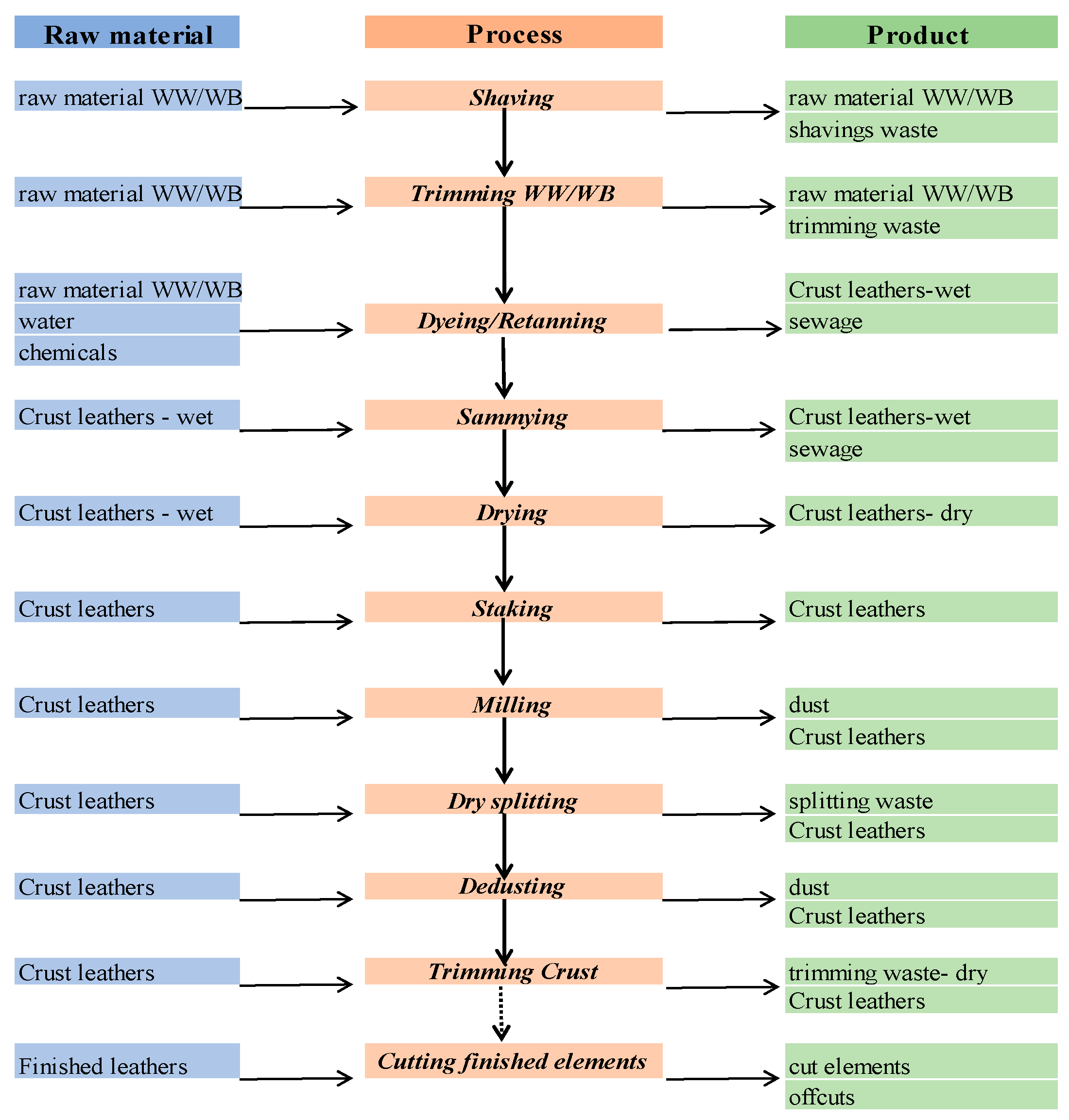
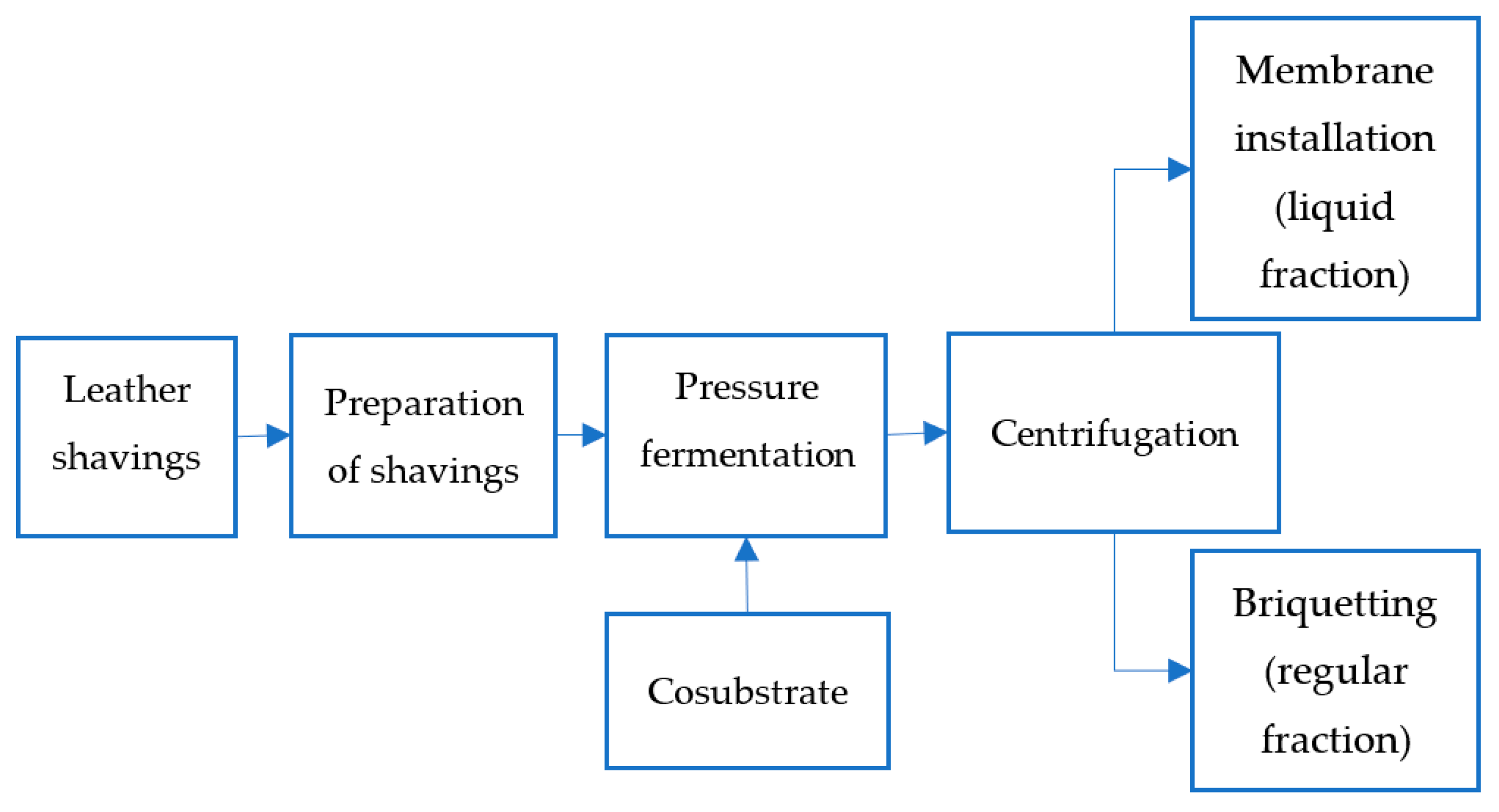

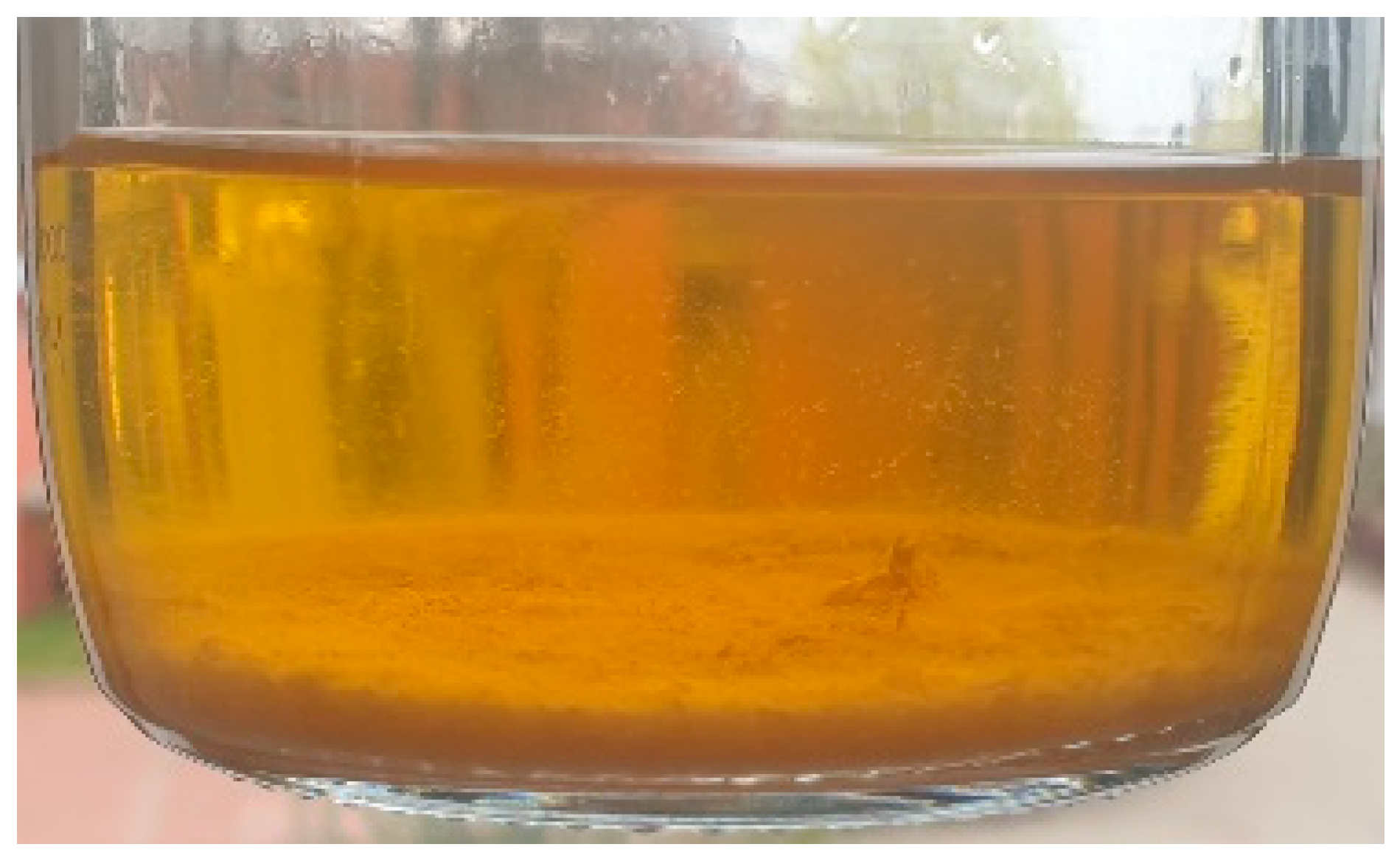
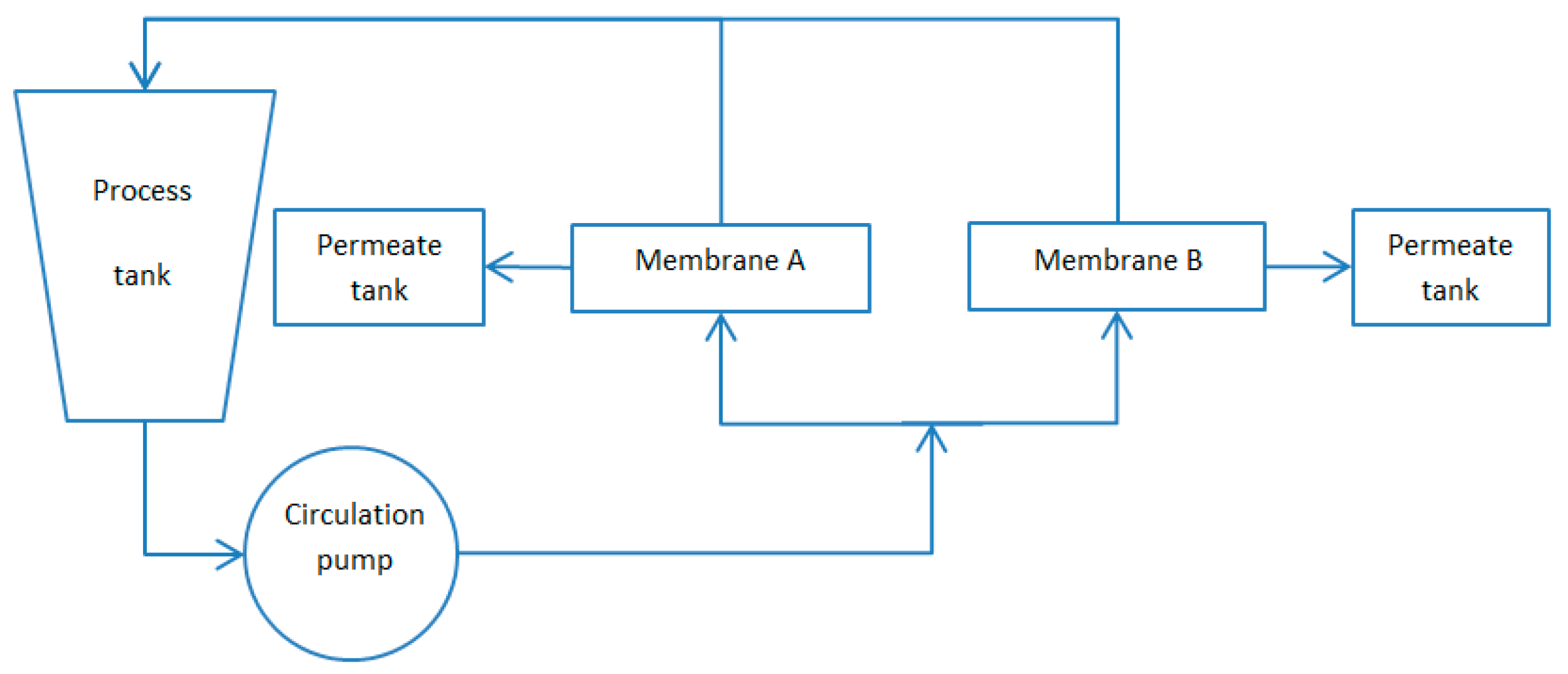

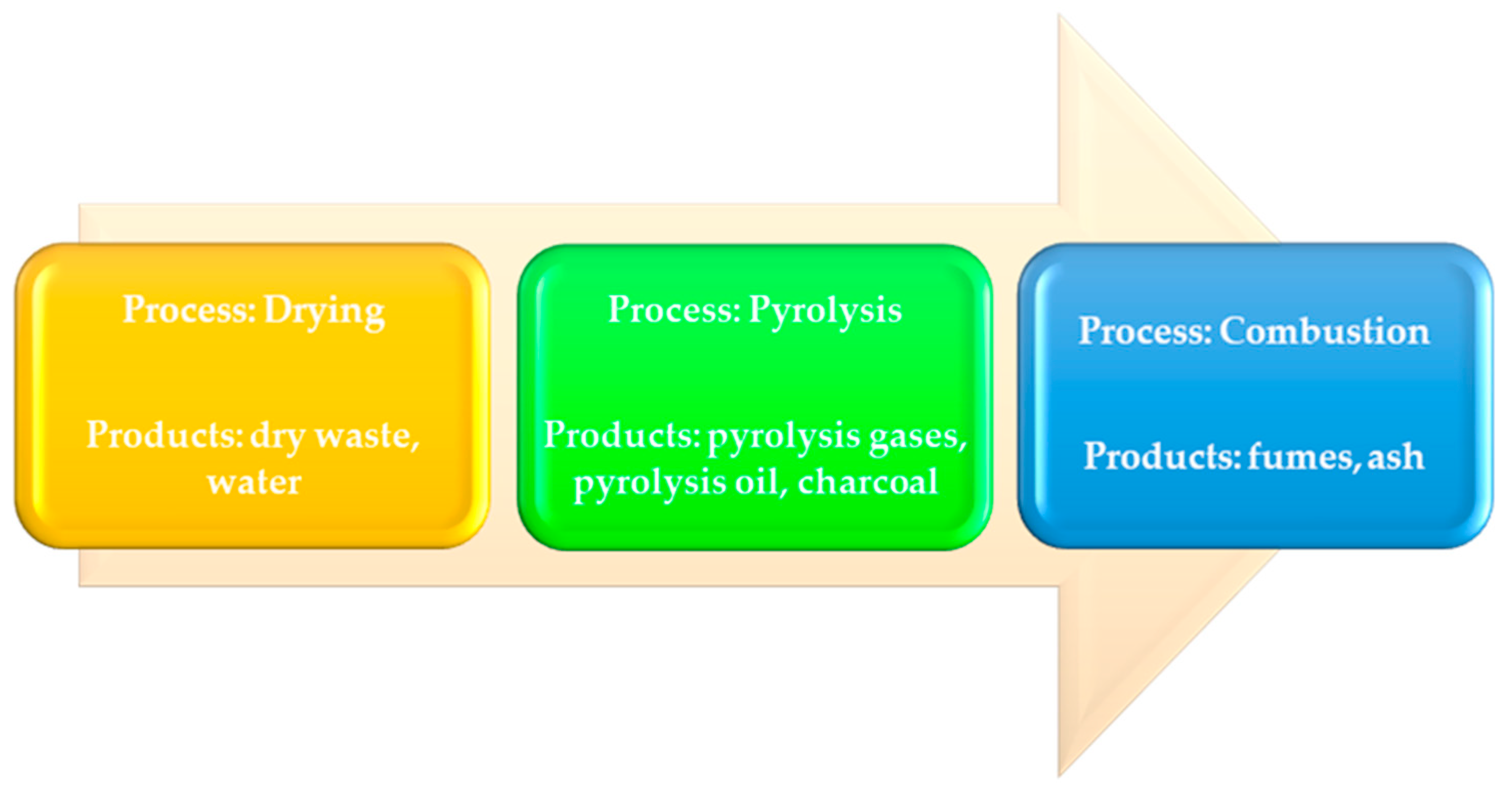
| Sample 1 | Sample 2 | |
|---|---|---|
| pH | 5.7 | 3.6 |
| Dry matter (%) | 56.6 | 55.6 |
| Total Kjeldahl nitrogen (% of DM) | 12.56 | 14.2 |
| Ammonium nitrogen (% of DM) | 0.04 | 0.07 |
| Sample 1 | Sample 2 | |
|---|---|---|
| pH | 7.66 | 7.66 |
| Biogas (m3/Mg) | 10 | 7 |
| Biogas (m3/Mg DM) | 18 | 13 |
| MizdraChrome-Free | Mizdraafter Enzymatic Hydrolysis | |
|---|---|---|
| Biogas (Nm3/Mg) | 10 | 248 |
| Biogas (Nm3/Mg ODM) | 18 | 438 |
| Methane (%) | - | 76 |
| Carbon dioxide (%) | - | 17 |
| Oxygen (%) | - | 2 |
| Other gases (%) | - | 5.5 |
| Values of Soaked Raw Leather (Mg) | Water (m3/Mg) | COD (mgO2/dm3) | BOD (mgO2/dm3) | Suspension (kg/Mg) | Cr3+ (kg/Mg) | S2− (kg/Mg) | SO42− (kg/Mg) | TKN (kg/Mg) | TDS (kg/Mg) | Fat (kg/Mg) |
|---|---|---|---|---|---|---|---|---|---|---|
| wet workshop | 7–25 | 120–160 | 40–60 | 70–120 | - | 2–9 | 5–20 | 9–14 | 200–300 | 5–8 |
| Tanning (tanning, coloring) | 1–3 | 10–20 | 3–7 | 5–10 | 2–5 | - | 30–50 | 0–1 | 60–120 | 1–2 |
| 4–8 | 15–40 | 5–15 | 10–20 | 1–2 | - | 10–40 | 1–2 | 40–100 | 3–8 | |
| Finishing | 0–1 | 0–10 | 0–4 | 0–5 | - | - | - | - | - | - |
| Total | 12–37 | 145–230 | 48–86 | 85–155 | 3–7 | 2–9 | 45–110 | 10–17 | 300–520 | 9–18 |
| Parameters | Raw Sewage |
|---|---|
| pH | 4–4.5 |
| conductivity (mS/mL) | 9–11 |
| Chlorides (mg/L) | 500–2000 |
| NH4 (mg/L) | 2–9 |
| Sulfates (mg/L) | 2000–4000 |
| chemical oxygen demand (mgO2/dm3) | 8000–14,000 |
| biological oxygen demand (mgO2/dm3) | - |
| Cr3+ (mg/L) | 12–40 |
| N (general) (mg/L) | 70–100 |
| P (general) (mg/L) | 30–60 |
| total suspended solids | - |
| Technical Parameter | Process Bath (A) | Raw Sewage (B) |
|---|---|---|
| dry matter (%) | 6.1 | 1.6 |
| chemicaloxygendemand (mgO2/dm3) | 52.500 | 4.450 |
| Designation | Raw Material | Permeate 0.14 μm | Permeate 300 kD | Permeate 15 kD | Permeate 3 kD | Concentrate |
|---|---|---|---|---|---|---|
| dry matter (%) | 6.1 | 5.4 | 5.7 | 5.3 | 5.0 | 14.5 |
| COD (mgO2/dm3) | 52.500 | 32.500 | 42.000 | 31.400 | 26.950 | 82.500 |
| Designation | Material | Permeate 300 kD | Permeate 3 kD | Concentrate |
|---|---|---|---|---|
| dry matter(%) | 1.6 | 1.5 | 1.5 | 2.5 |
| COD (mgO2/dm3) | 4.450 | 3.050 | 2.950 | 8.050 |
Disclaimer/Publisher’s Note: The statements, opinions and data contained in all publications are solely those of the individual author(s) and contributor(s) and not of MDPI and/or the editor(s). MDPI and/or the editor(s) disclaim responsibility for any injury to people or property resulting from any ideas, methods, instructions or products referred to in the content. |
© 2023 by the authors. Licensee MDPI, Basel, Switzerland. This article is an open access article distributed under the terms and conditions of the Creative Commons Attribution (CC BY) license (https://creativecommons.org/licenses/by/4.0/).
Share and Cite
Wrzesińska-Jędrusiak, E.; Czarnecki, M.; Kazimierski, P.; Bandrów, P.; Szufa, S. The Circular Economy in the Management of Waste from Leather Processing. Energies 2023, 16, 564. https://doi.org/10.3390/en16010564
Wrzesińska-Jędrusiak E, Czarnecki M, Kazimierski P, Bandrów P, Szufa S. The Circular Economy in the Management of Waste from Leather Processing. Energies. 2023; 16(1):564. https://doi.org/10.3390/en16010564
Chicago/Turabian StyleWrzesińska-Jędrusiak, Edyta, Michał Czarnecki, Paweł Kazimierski, Paulina Bandrów, and Szymon Szufa. 2023. "The Circular Economy in the Management of Waste from Leather Processing" Energies 16, no. 1: 564. https://doi.org/10.3390/en16010564
APA StyleWrzesińska-Jędrusiak, E., Czarnecki, M., Kazimierski, P., Bandrów, P., & Szufa, S. (2023). The Circular Economy in the Management of Waste from Leather Processing. Energies, 16(1), 564. https://doi.org/10.3390/en16010564








